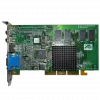The ATI Rage Series is a line of graphics processing units (GPUs) developed by ATI Technologies, a Canadian graphics card and chipset manufacturer. Introduced in the mid-1990s, the Rage Series played a significant role in the evolution of graphics technology during that era.
The initial release, the ATI Rage 128, debuted in 1997 and was one of the first GPUs to integrate 3D acceleration, 2D graphics, and DVD playback capabilities on a single chip. This integration marked a step forward in graphics card design, as it allowed for improved multimedia performance and reduced costs for manufacturers and consumers.
However, the Rage 128 faced competition from NVIDIA's RIVA TNT series, which offered better 3D performance. In response, ATI released the Rage 128 Pro, featuring higher clock speeds and improved performance. The Rage Fury MAXX, another variant, attempted to stand out by incorporating two GPUs on a single card, but driver issues and lackluster support limited its success.
The ATI Rage Mobility line targeted the laptop market with power-efficient graphics solutions. These chips provided acceptable performance for their time, enabling gaming and multimedia on portable computers.
The culmination of the Rage Series was the ATI Rage 6 (also known as the Rage 128 Magnum or Radeon DDR), which eventually evolved into ATI's Radeon graphics card series. The transition to the Radeon brand marked a shift towards more advanced 3D performance and better support for emerging technologies like DirectX and OpenGL.
Despite being overshadowed by NVIDIA's more successful offerings, the ATI Rage Series was instrumental in shaping the graphics landscape. It showcased the potential of integrating multiple functionalities on a single chip and set the stage for ATI's subsequent successes with the Radeon series. The lessons learned from the Rage Series contributed to ATI's advancements in graphics technology, eventually establishing the company as a major player in the GPU market until it was acquired by AMD in 2006.



